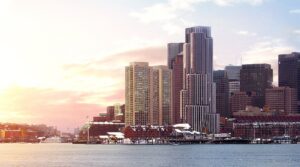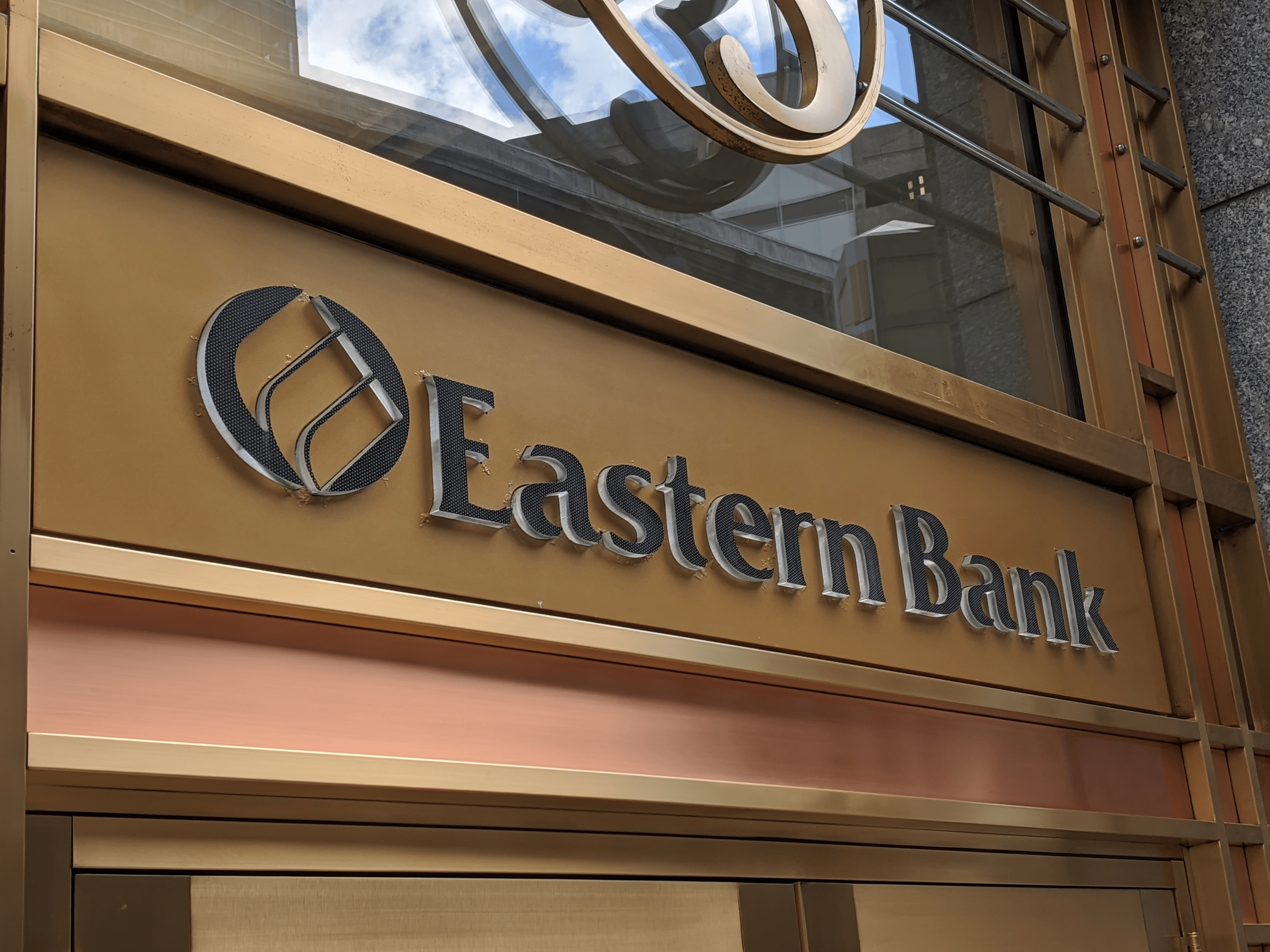
A rendering from The Chiofaro Co. shows its proposed 600-foot Pinnacle tower in context with the downtown Boston skyline. Image courtesy of Kohn Pederson Fox Assoc.
Opponents of a proposed downtown Boston tower cheered Mayor Michelle Wu’s decision to relaunch a contentious waterfront zoning process Wednesday, but the building’s developer warned that “immediate further cooperation” was needed to make sure the resulting plan was able to protect the city from floods.
The city sent a letter to state environmental officials Feb. 16 notifying them that the city will be filing an amendment to its downtown municipal harbor plan, which governs development on or near the waterfront. The letter also states the city means to begin a municipal harbor planning process for East Boston in short order.
While Wu’s mayoral predecessor, Kim Janey, withdrew the 2018 municipal harbor plan last summer, which sets zoning and other rules for all waterfront development, it was left to Wu convince the Baker administration to accept the move. State officials OK’d the plan’s withdrawal last month.
“It’s frustrating for everyone to be at this point in the conversation [again] but each year we see the impacts of climate change intensify and sea level rise go up,” Wu said during a Wednesday afternoon appearance on GBH News’ “Boston Public Radio” show. “We have to recover from the pandemic in an equitable way, so we want to get it right.”
Two Towers’ Uncertain Future
The decision leaves the fate of two proposed towers up in the air: a 357-room hotel high-rise on the James Hook & Co. lobster pound property and developer Don Chiofaro’s long-mooted “Pinnacle” office-residential tower next to the New England Aquarium.
Chiofaro’s tower has been the focus of anger from neighbors in the Harbor Towers condominium development and conservationists, who argue that the project doesn’t offer enough protection from coastal flooding and won’t ensure “equitable” access to the waterfront. The foot of Long Wharf is one of the lowest-lying parts of the downtown Waterfront.
Officials at the New England Aquarium, also a vociferous opponent of the Chiofaro tower, praised Wu’s move.
“We look forward to participating in a new Downtown Waterfront Municipal Harbor Planning process that is centered in accessibility, resiliency, and equity for all,” New England Aquarium President and CEO Vikki Spruill said in a statement. “We applaud Mayor Wu for her decisive action to launch a new planning process that will prioritize these important issues, as well as better engage and respond to residents from across the city who care deeply about climate justice and the future of our waterfront.”
In a statement emailed to Banker & Tradesman, The Chiofaro Co. said a recent winter storm which nearly caused catastrophic flooding, save a fortuitous delay that moved it outside the high-tide window, reinforces the need to take climate change planning seriously.
“We are in full agreement with Mayor Wu that climate resiliency and equity are urgent considerations for the future of our entire waterfront,” the statement said. “It’s no exaggeration to say that in recent months Boston has been playing chicken with nature and is lucky to have escaped with near-misses. We’re committed to our neighborhood and our investment and will continue engaging in the collaborative efforts underway via the Wharf District Council’s Climate Resiliency Task Force. However, immediate further cooperation among government, business, non-profit and residential stakeholders will be necessary to realize our broader collective goals.”
East Boston Plan in Motion
At the same time, Wu’s office said in a statement that said she would also be launching a municipal harbor planning process for East Boston. Thanks to a former railroad line that originally connected to its wharves and low-lying coastal land around its Central Square commercial district, the neighborhood is extremely vulnerable to sea level rise.

With sea levels forecast to rise between 9 inches and 36 inches thanks to climate change, a severe storm could put substantial portions of Boston underwater by 2030 (dark blue), and even more by 2070 (light blue). Image courtesy of the BPDA
A new report from scientists at the National Oceanic and Atmospheric Administration, the National Weather Service’s parent agency, says America will likely see a century’s worth of sea level rise in the next 30 years, with the East Coast bearing the brunt of that.
In a statement issue by Wu’s office, Boston Planning & Development Agency Director Brian Golden said the East Boston plan would build on the work already done by the agency’s PLAN: East Boston initiative to, formally writing into zoning what has previously effectively only been guidance the BPDA has given developers.
“A robust, community-driven municipal harbor planning process in East Boston will build upon PLAN: East Boston to create a predictable framework for future development that prioritizes equity and resiliency,” Golden said. “We must work to protect the neighborhood’s residents and small businesses from the impacts of sea level rise and coastal storms.”
In recent years, projects like LendLease’s Clippership Wharf and The Davis Cos.’ The Mark have built up flood defenses along some parts of the East Boston waterfront. However, gaps remain even as the neighborhood is emerging as another development hot spot, with some comparing its appeal to that of a less-expensive version the high-end Seaport District across the harbor, thanks to its closeness to downtown.
Updated 5:30 p.m., Feb. 16, 2022: This story has been updated to add comment from The Chiofaro Co.






